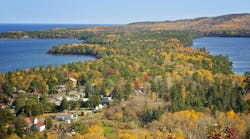
What’s in a name? For one Montana community hoping to restore a polluted waterway, potentially a great deal.
In Butte, MT, a mostly dry channel running through town has long been known as the Metro Storm Drain. The channel is contaminated with mine and smelter tailings, which some residents want to see removed. Four years ago, three local activists filed a lawsuit against the state to have the channel renamed Silver Bow Creek. Last week, the court ruled in their favor.
What’s in a name? For one Montana community hoping to restore a polluted waterway, potentially a great deal. In Butte, MT, a mostly dry channel running through town has long been known as the Metro Storm Drain. The channel is contaminated with mine and smelter tailings, which some residents want to see removed. Four years ago, three local activists filed a lawsuit against the state to have the channel renamed Silver Bow Creek. Last week, the court ruled in their favor. [text_ad] But here’s where things get complicated. The plaintiffs contend that now that the channel is officially called Silver Bow Creek, the state has a responsibility to restore it and make it a free-flowing creek once again. (The state disagrees.) They also want the tailings removed—and in this, at least, the state concurs. For almost nine years, the state of Montana has been arguing with EPA over what should be done about the pollutants. Some are underground tailings, while others are on the surface. In 2006, EPA made the decision that the tailings should be left in place. According to EPA’s written decision at that time, Silver Bow Creek actually starts at the confluence of the (now renamed) Metro Storm Drain and Blacktail Creek. Yet the local activists have maintained that the channel in question was at one time an upstream reach of Silver Bow Creek—as the court’s decision seems to acknowledge. Funding has been available for a cleanup and restoration effort of lower Silver Bow Creek, and the plaintiffs, who have formed an organization called the Silver Bow Creek Headquarters Coalition, contend that some of that money should be used to clean up the newly renamed dry stretch as well. As it stands now, stormwater runoff flowing through the channel continues to carry tailings to lower Silver Bow Creek, so removing them would make sense. One coalition member has also outlined a plan for putting water permanently back into the channel—perhaps piping it from Silver Bow Creek’s headwaters—but the details have not been worked out. You can see more on the story here in an article from the Montana Standard.But here’s where things get complicated. The plaintiffs contend that now that the channel is officially called Silver Bow Creek, the state has a responsibility to restore it and make it a free-flowing creek once again. (The state disagrees.) They also want the tailings removed—and in this, at least, the state concurs.
For almost nine years, the state of Montana has been arguing with EPA over what should be done about the pollutants. Some are underground tailings, while others are on the surface. In 2006, EPA made the decision that the tailings should be left in place. According to EPA’s written decision at that time, Silver Bow Creek actually starts at the confluence of the (now renamed) Metro Storm Drain and Blacktail Creek. Yet the local activists have maintained that the channel in question was at one time an upstream reach of Silver Bow Creek—as the court’s decision seems to acknowledge. Funding has been available for a cleanup and restoration effort of lower Silver Bow Creek, and the plaintiffs, who have formed an organization called the Silver Bow Creek Headquarters Coalition, contend that some of that money should be used to clean up the newly renamed dry stretch as well.
As it stands now, stormwater runoff flowing through the channel continues to carry tailings to lower Silver Bow Creek, so removing them would make sense. One coalition member has also outlined a plan for putting water permanently back into the channel—perhaps piping it from Silver Bow Creek’s headwaters—but the details have not been worked out.
You can see more on the story here in an article from the Montana Standard.About the Author
Janice Kaspersen
Janice Kaspersen is the former editor of Erosion Control and Stormwater magazines.


